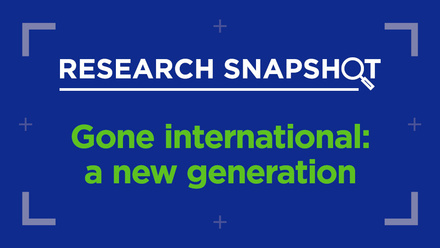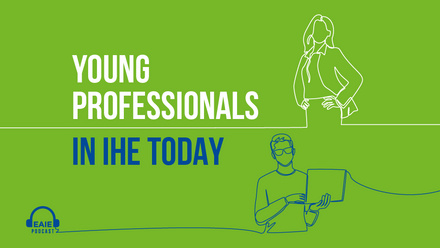International virtual traineeships: 5 tips for transversal skills

According to the latest Erasmus+ Impact Study (EIS), 40% of Erasmus+ traineeship participants were offered a job after finishing their work placements, up 4% from the previous study. Traineeships, especially those done abroad, are considered the ideal link between the academic world and the world of work, as they prepare students for the demands of future workplace environments. But does this still hold true after two years of the COVID-19 pandemic, during which exchanges – including traineeships – have gone mostly virtual?
Well, there is not enough evidence yet to give a definitive answer. However, recent studies bode well for the effectiveness of international virtual traineeships – but only if certain sensitive areas are addressed. These key areas are similar to those that are important for the success of in-person traineeships, as our previous blog outlined, but the focus and urgency have changed.
1. Ensure students are prepared for virtual traineeships
This is a must! All traineeships – regardless of whether they are physical or virtual – should be an integral part of the curriculum, thus clearly contributing to both the intended domain-specific and transversal skills profiles of graduates. This also requires laying the groundwork for gradually building these skills right from the start of any study programme.
By the time students start their traineeships, they should have been able to develop their digital, self-management and cultural competences to a degree that allows them to cope with the challenges and fully leverage the benefits of virtual traineeships. This means that the responsible supervisors/academics need to check whether students have the degree of self-regulated learning and independence to sustain their motivation and drive in a virtual environment, where opportunities for accidental, informal learning are rare to non-existent. Students who lack this capacity should be advised to carry out a physical traineeship. If traineeships are not part of the formal curriculum, students could be prepared, for example, by participation in one of the many Erasmus+ Virtual Exchange (EVE) initiatives to hone their digital and (cultural) communication skills.
This preparation will support students in recognising and coping with cultural differences such as attitudes towards time, meeting and work routines pertaining to hierarchical structures or uncertainty avoidance. Cultural awareness and sensitivity are even more relevant and need to be carefully considered in the seemingly neutral virtual space.
2. Design realistic and appropriate learning outcomes
Not all skills can be fostered equally well in virtual and physical environments. While gains in self- and time-management skills, usage of digital tools for collaboration and communication, flexibility and pro-active problem-solving are reported in the scarce empirical evidence already available, intercultural competence and associated attitudes need special effort and proper scaffolding in order to be developed.
Some of these, like tolerance of ambiguity or resilience, may not lend themselves easily to being verified through formal assessment and should therefore not be formulated as an intended learning outcome. However, this does not mean that these skills cannot be improved in virtual traineeships; they should still be addressed in meetings between the student and the academic supervisor or mentor.
3. Clearly communicate intended and achieved learning outcomes
The Erasmus+ traineeship agreement provides the proper instrument to define and document the intended learning outcomes as well as the monitoring and assessment methods. It can only function, however, if all stakeholders involved – academic supervisors, students and company representatives – are not only involved in drafting it, but truly committed to it.
Using the Erasmus+ traineeship agreement as a roadmap with jointly agreed routes and checkpoints, students can be steered towards the defined destination, the intended learning outcomes (LOs). Quality here relates to realistic, authentic and achievable LOs and, often, less is more. As we will explain in the fifth tip below, optimal LO design is the prerequisite, but the choice of monitoring and assessment methods is key to securing the achieved learning outcomes.
4. Ensure space is available for socialising and intercultural encounters
The ‘water cooler’ or ‘coffee machine’ effect does not happen naturally in a virtual space. This lack of informal learning and socialising opportunities has been found to account for feelings of isolation and disconnectedness, and even for dropping out from virtual traineeships altogether. Thus, space for socialising and familiarisation with the workplace culture needs to be intentionally built into the work routine. These socialising moments, such as virtual coffee breaks, joint lunches, birthday celebrations or happy hours need to happen on a regular basis and need to be integrated into the monitoring and evaluation scheme.
Furthermore, mentoring or at least a set feedback structure, both with a company representative and the academic supervisor, needs to be in place. The more tightly this structure is designed the better, but a minimum of one such meeting per week should be considered necessary. Reports stress that these feedback loops should be carried out synchronously in a videoconferencing format to enable prompt and constructive discussions that foster learning. Again, the Erasmus+ traineeship agreement provides a starting point to establish such structures, as it requires the indication of a mentor within the company, who should not be identical with the project or work supervisor.
5. Plan and implement demonstration and articulation of skills gain
Apart from the domain-specific learning outcomes that are usually assessed by some kind of product or project outcome, it is essential to support students in clearly identifying the achievements related to transversal skills. Apart from aspects of grading, the skills gain needs to be supported by formative assessment, so that continuous learning and reflection are stimulated throughout the duration of the virtual internships. The exact nature of the assessment is of course dependent on the discipline and the circumstances of the specific traineeship, but students should be given the opportunity to share their learning with other students, potentially through posters, interviews, video presentations, reflective traineeship blogs or portfolios, among others.
To conclude, proper and careful scaffolding of traineeships abroad is a relevant success factor for students’ skills gain in any case, but even more so in a virtual environment. Our upcoming EAIE Online Academy course on ‘Designing learning outcomes for traineeships abroad’ will dive deeper into this important topic on 11 and 13 May; be sure to join us to share experiences with peers and learn more about designing high-impact traineeships abroad in the current environment.






